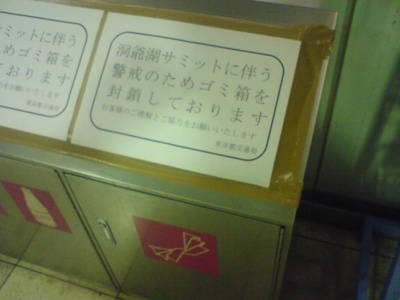A few months ago when I was posting random tidbits of stuff from the Japanese news media to this blog, I came across an article about a group suicide that happened in a hotel less than an hour from where I live. Three people–two men and a woman–packed into a bathroom, sealed the door with duct tape and mixed together some household chemicals to create hydrogen sulfide gas, which in high enough concentrations kills in less than 15 seconds. It was the first time I had heard of that method being used, and I thought it was interesting but too depressing to post. Also, I didn’t want to give anyone any ideas. It’s not too difficult to figure out that it’s simply a matter of finding something made with hydrochloric acid and something else containing sulfur, and mixing the two together in a bowl.
Weeks went by and I slacked off from reading news articles in Japanese, because frankly, it’s a time consuming pain in the ass, and keeping up with election news from the US in English requires far less effort in comparison. But eventually I did go back to it. (It’s what I do when I can’t sleep at night.) That’s when I discovered that suicide by hydrogen sulfide had become a fad. Between the beginning of this year and the end of May, there have been 517 deaths nationwide, compared to only 29 in all of last year. In at least one incident, the elderly parent of a suicide victim was found dead just outside the bathroom where the 39 year old man took his own life. In far more cases, entire neighborhoods have had to be evacuated until the air was deemed safe to breathe.
People who are suicidally depressed often feel like they just want to disappear; to go to sleep and never wake up. On various online bulletin boards (such as 2chan), blogs and websites, death by hydrogen sulfide has been toted as a way to take one’s own life quickly, easily, and painlessly. In fact, when you search Google for the term “hydrogen sulfide” in Japanese, the second highest ranking result after the Wikipedia article is a web page giving a step-by-step instructions on what chemicals to use, how to buy them, how much to mix together given the size of the room, and even a PDF sign to print out and tape to a door warning others to stay away and call authorities. Two links at the very bottom of the page take you to the sites for two suicide prevention organizations. I don’t know what the author’s point is, given the contents of the rest of the page.
But here’s what really blows me away: Even though for the past 10 years in Japan over 30,000 people have committed suicide annually, the government is doing very little to combat the problem. That statistic is four times the number of people who die in traffic accidents every year. On year’s total is roughly equal to the number of soldiers killed and wounded since the beginning of the Gulf War.
Nearly 20% of suicides are attributed to depression, the rest mostly to physical ailments or unsurmountable debts. It’s the ones caused by depression that are the most disturbing to me. If 6,060 people had died in 2007 from any other cause–homicide, SARS, AIDS, paper cuts–the news media would be in hysterics over the epidemic and the government would throw billions of yen at the problem. As it stands, the only concrete action I’ve been able to dig up on the part of the government is their declaration to cut the suicide rate by 20% by 2016. Maybe I just haven’t hit Google paydirt yet on what’s actually being done; the relevant section of the National Institute of Public Health’s website has a pretty picture of some flowers to show their concern, but the page hasn’t been updated since 2003.
I don’t know what my point is, other than 30,000 people out of a total population of 127 million is a hell of a lot of people, and the thought blows my mind. That, and I’d like to see psychotherapy cognitive behavioral therapy covered by national health insurance. Taking antidepressants without therapy is like taking anti-cholesterol medication but still eating at McDonald’s three times a day.


